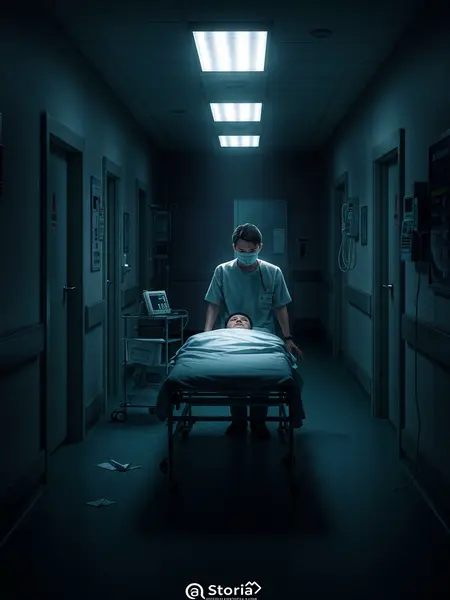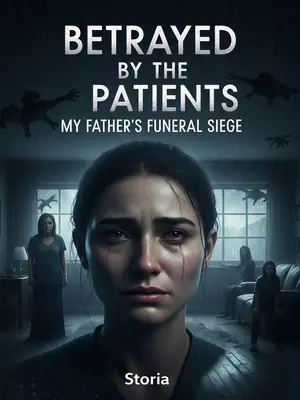Chapter 2: Clues and Uncertainty
The first result back was the blood count. Basically normal; his white blood cell count wasn’t high, so probably not regular pneumonia. Pneumonia usually comes on quick, not over a month.
I explained the results in plain English, sketching a little chart on the back of his discharge instructions. He nodded, but I could see him trying to process it all.
One thing caught my eye—his lymphocyte count was just under normal. A clue, but not an answer.
Next came his GI symptoms. I asked about appetite, digestion. He looked embarrassed, glancing at his girlfriend like he wished he could disappear.
I’d asked him to leave a stool sample, but he said he couldn’t—no urge. He apologized, cheeks flushed, mumbling he’d try again later.
His girlfriend jumped in: he’d already had diarrhea five times today, probably emptied out. She said his stomach issues weren’t new—about a month, coming and going, flaring up after questionable food, then lasting all day.
She recited the timeline like someone who’d been keeping a symptom diary—dates, foods, symptoms. She was more his health advocate than just a worried girlfriend.
"Can stomach bugs last that long?" he asked, hope and dread warring in his eyes.
I shook my head gently. Most stomach bugs burn out in days, maybe a week. Anything longer, especially with fever, means we have to dig deeper.
What exactly was going on? The room felt thick with questions. Sometimes in medicine, you have to live in that uncertainty, waiting for clues.
Was it just TB? Or both lung and intestinal TB? Or something else entirely—lymphoma, inflammatory bowel disease? My mind spun. This is the part of the job that keeps you up at night.
I admitted as much, keeping my tone steady. Sometimes "I don’t know" is the most honest answer you can give.
There were plenty of other patients that night, so I gave him the best workup I could and figured the real answers might come later.
Soon, the CT result came back. He rushed over, breathless, waving the printout, his voice barely above a whisper. His girlfriend hovered behind him, face etched with worry.
I looked at the scan—lesions in both upper lungs. It really did look like TB. The report said TB was suspected.
I scrolled through the images—nodules, upper lobe infiltrates. Textbook, and my stomach dropped a little.
I told him it could be TB, but confirming it takes more tests. A CT alone isn’t enough. I suggested he be admitted for a full workup—if it was TB, he’d need to be moved to infectious diseases.
I explained the next steps—admission, isolation, CDC precautions. I tried not to overwhelm him, but his eyes got wider with every word.
His eyes brimmed with fear. I tried to reassure him: "Plenty of people have made it through this. You’re young and otherwise healthy—odds are good."
His girlfriend squeezed his hand. “We’ll deal with whatever comes. You’re not in this alone.” Her calmness filled the space where panic could have crept in.
Suddenly, he felt his stomach cramp and bolted for the bathroom. He moved so fast his hospital gown fluttered behind him, one hand pressed to his gut, the other gripping the doorframe.
His girlfriend watched after him, worry written all over her face.
She turned to me, voice low but urgent—could the diarrhea be intestinal TB? She’d checked, and TB can hit lungs, intestines, lymph nodes. One sign of intestinal TB is diarrhea.
She rattled off CDC facts, voice catching as she squeezed her phone tight. Her fear was starting to show beneath all that research.
I explained: TB can hide out in your body like a squatter in an abandoned house—quiet at first, then suddenly wrecking the place. It can travel anywhere, so yes, lung, intestinal, and lymph node TB can happen together. But more tests were needed.
I gently reminded her—since he might have TB and she was caring for him, she should wear a mask, maybe keep some distance. I offered her a fresh N95, even showed her how to fit it. She listened closely, taking mental notes.
She brushed it off with a nervous laugh, bravado hiding fear. “I never get sick. I’m basically indestructible. Someone’s gotta keep him from living on gas station burritos.”
I tried to keep it light, but firm. “Even marathon runners can catch a bug like this. Take care of yourself, too.”
She nodded, saying if it was TB, so be it—she wouldn’t abandon him. He was working so hard for their first house, never taking a vacation. She had to be there for him.
Her words hung in the air, quiet and fierce. I thought of all the couples I’d seen splinter under stress, and silently hoped they’d make it through.
Honestly, I was moved. Watching her, I wondered if I’d ever had someone in my corner like that. Maybe that’s why I never left the night shift.
When I had a free moment, I pieced together his timeline. TB still seemed likely.
The early stage of lung TB usually has no obvious symptoms. As it gets worse—fatigue, loss of appetite, weight loss, insomnia, night sweats, palpitations, low fever. Most people don’t notice until there’s a cough, chest pain, or even blood.
I explained the classic symptoms, watching for recognition. He nodded, remembering the brain fog and sweat-soaked sheets.
He’d had a low fever for over a month—classic for active TB. He should have come sooner, but kept popping Tylenol, thinking it was just a cold.
I reassured him—most folks ignore the signs until they can’t. Life moves fast; it’s easy to downplay what you don’t want to face.
The diarrhea could be intestinal TB. TB can infect the lungs, and, rarely, the gut too—usually with stomach pain and diarrhea.
I explained, but the puzzle was he never had stomach pain—almost all intestinal TB patients do. That stumped me.
I scribbled a note to consult infectious diseases. Sometimes, medicine throws you a curveball. You have to admit when you’re stumped.
Turns out, I was still pretty green. Medicine always finds new ways to humble you.
I didn’t have time to dwell. The ER was filling up. I flagged a nurse to start his admission paperwork.













